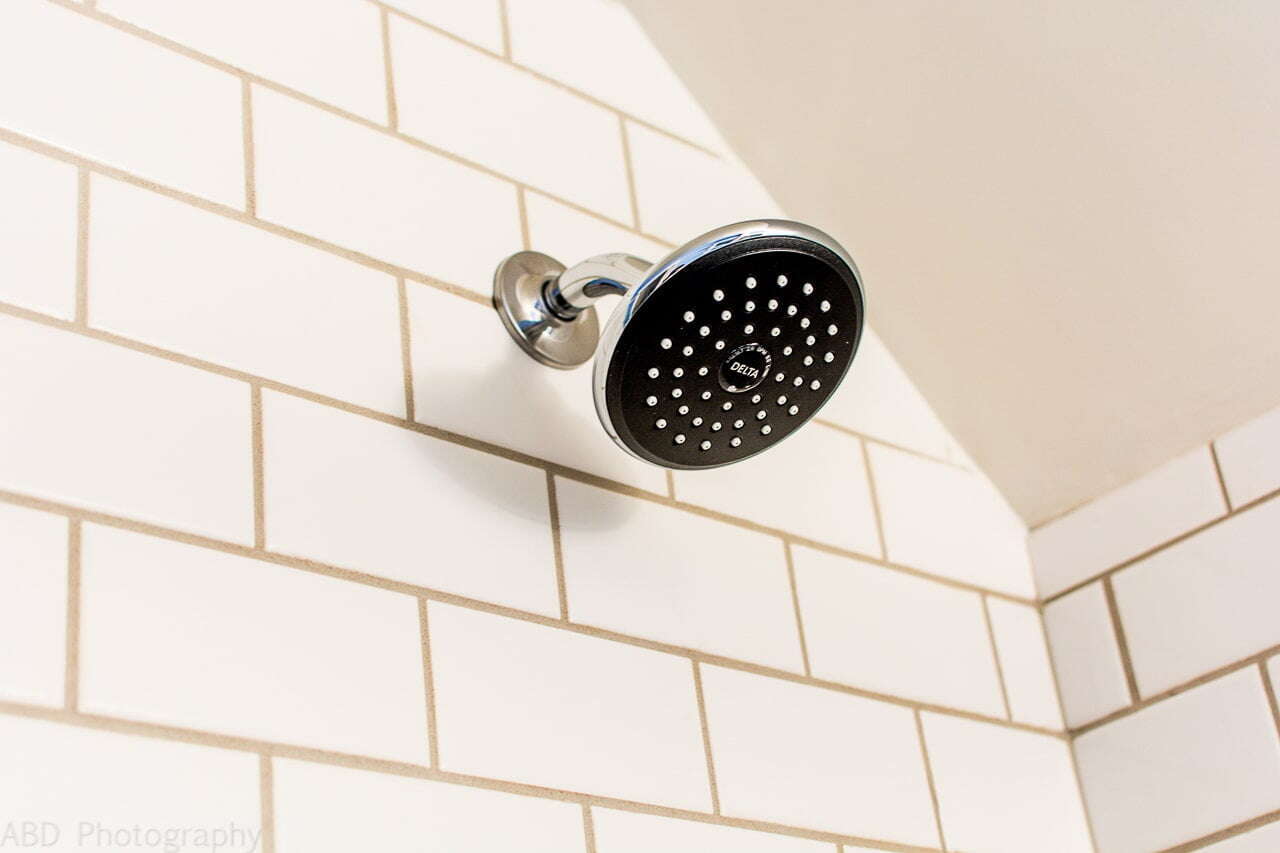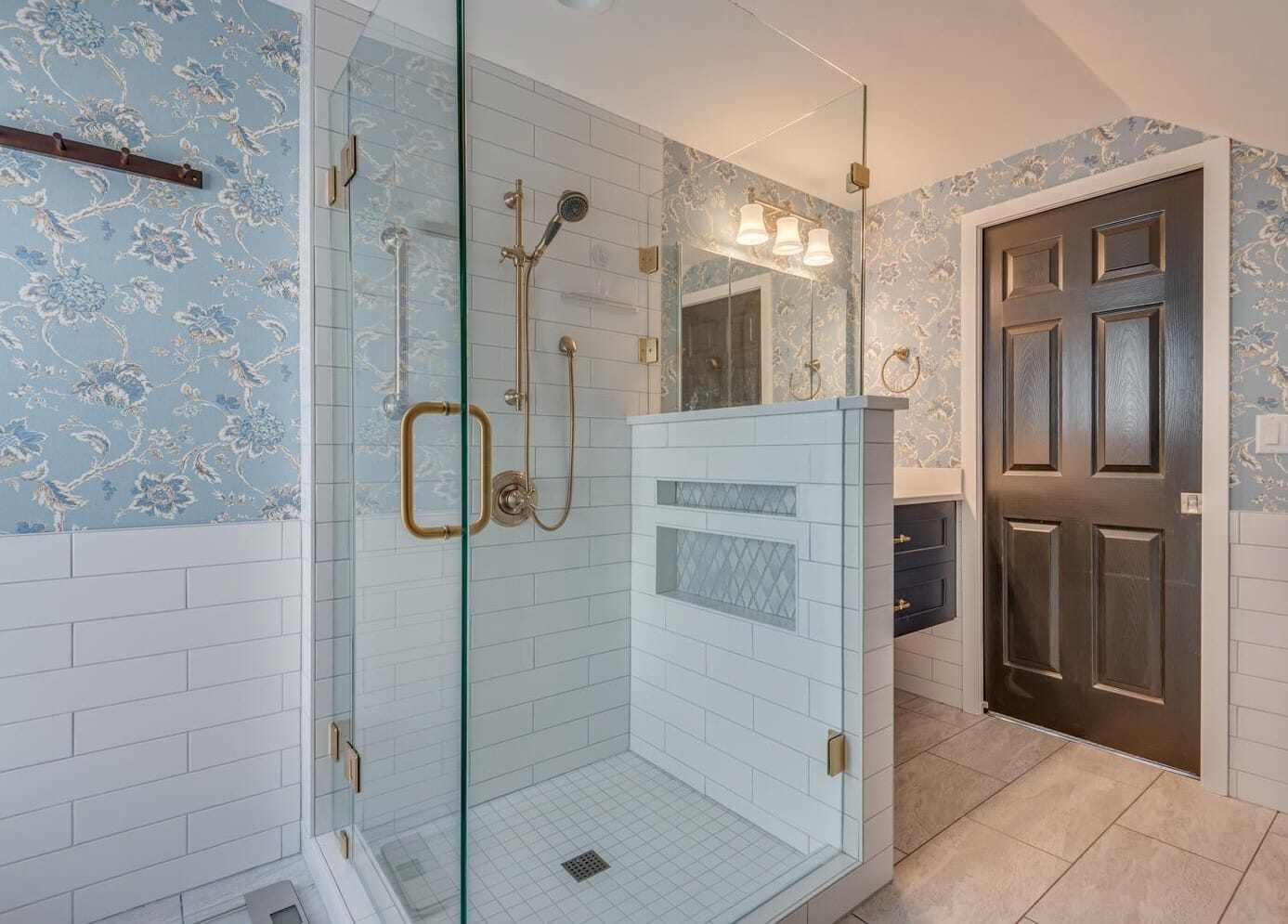With all of the fixtures and finishes available these days, your bathroom can be functional while truly reflecting your lifestyle. And the centerpiece of many bathrooms is a large tile shower. But how much does a tile shower cost?
Increasingly, we’re seeing clients shift away from large alcove and sunken jetted tubs for new larger tile showers. Not only are they more modern, but updated design elements make them easier to use for all ages. They can help give your bathroom a spa atmosphere and make it a place to unwind. So, what sort of budget will it take to build the shower of your dreams? Let’s look at some options…
Components of a Tile Shower
Before we dive straight into the figures, let’s take a look at five key elements that go into the design and build of a new tile shower, and factor into the cost:
- Shower pan
- Tile
- Plumbing fixtures
- Shower enclosure
- Accessories
Shower Pan
The “shower pan” is really just another name for the floor of your shower. And it comes in a few different options.

Acrylic pan: This is the least expensive option. The pan is set and the tile is installed on top of the base to complete a water tight system. The pan typically comes in white and has a threshold about 3 inches tall.

Tiled pan: For a more custom look, a tiled pan is the next step up. For a standard tile pan, you are limited to tiles that are 3 inches or smaller as they are able to follow the slope of the pan and drain the water. That means you could choose a beautiful mosaic or a 2×2 inch square style that could then be used as an accent tile in other places in the shower. You will also have a threshold about 3 inches tall with this option.

Zero clearance pan: This type of pan is set slightly into the floor system so that there is no step up into the shower. One of the perks with this system is that you are able to carry the same flooring from outside the shower to inside, with a seamless look. There are also no restrictions on tile size. That means you can do a 5 inch hexagon or a 12×24 inch large scale tile. The options are limitless.
Tile
Of course, no tile shower is complete without the tile! When it comes to colors and patterns, the possibilities can seem endless, but the location of the tiles can dictate which styles may work best for you.

Shower walls: Tiles for your shower walls come in a wide variety of sizes. The smallest starts at 3×6 inches. The most requested tile size is 12×24. The size of tile you select will depend on the look you are going for. Typically, larger scale tiles lend more towards a modern look, where smaller ones can skew more classic.

Shower floor: The tiles for your shower floor will depend upon the type of shower pan you select. As noted above, if you do a pan with a threshold, think smaller tiles. If you have no threshold, then larger tiles can be used.

Decorative tiles: No matter if it’s the shower walls or the floor, something like a mosaic or glass tile insert can add a pop of visual interest. Several options are available from the simple to the intricate. This is a great way to really show off your shower style!
Plumbing Fixtures
Once you’ve selected tile, it’s time to move on to the fixtures. From the type of shower head to your drain coverings, you’ll need to make a few more decisions here.

Shower drain cover: You guessed it, this is the fixture that makes the hole in the floor of your shower a bit less noticeable, and a lot more safe. Most commonly, it comes in a circular design, but you can also choose from square and linear options.

Secondary shower head or hand shower: Also called a “dual unit,” a secondary shower head includes an additional head in a single unit, attached to the wall. A hand shower, however, is usually attached to a slider bar or coil that’s separate from the fixed head, allowing you to manually move it.

Body sprays: These are essentially small shower heads attached at varying points on the walls to give a full body shower experience. They usually come in multiples of 2, 3, or 4 and can be mounted on the same or opposite walls.

Shower valve and/or diverter: Shower valves are designed to better manage water flow and temperature, so you’re not suddenly hit with a burst of hot water when someone flushes the toilet, or a reduction in water pressure when the lawn sprinkler system turns on. A diverter valve switches water flow from the bathtub faucet to the shower head, allowing you to have a shower and tub in the same space.

Fixed shower head: As the name suggests, a fixed shower head is connected to the wall via a shower arm. With this type, you can have a massage style, rainfall, and even-water saving for a bit of variety, but the full head attachment is a single component that’s affixed to a set position in your shower.
Shower Enclosure
How you enclose your shower is another important decision, whether you want full glass, nothing at all, or something in between.

Full glass: Surrounding your shower with glass is one of the most common enclosures. It provides an open, streamlined look and can make the shower area feel larger. The structure typically consists of single glass panels with a complementary glass door.

Partial height wall with glass panel and door: If you’re looking for more tile niches and a bit more privacy, a partial height wall is a great option. It also means less glass to clean. A wall usually about 42 inches tall is built either at the front or side depending on the shower layout, then a glass panel is placed on top. That’s then connected to another panel or a glass door. This system comes with a lot of design flexibility.

Open shower: If glass isn’t your style and space allows, an open shower (one with no door) could be an option. To create this look, you could do a full height glass wall and an opening for a door, just not install one. Or you could go very European with no walls. That usually entails a bit of extra cost to protect the rest of the bathroom space from splashing water.
Accessories
The remaining items to think about when it comes to your new tile shower cost are the accessories. You may want to include a bench. Or a niche or two. Considering these as part of the initial design process can save time later on. Here are some options.

Tile niche: A niche is simply an area of the shower wall that has been recessed to use for storage. It’s convenient for holding shampoo bottles, soap, or other shower items. You can have or multiple niches, and the size can vary depending on your needs and the shower space available.

Fixed shower bench: A built-in bench is a popular accessory in newer showers. You can use it to relax on if you take longer showers. It can help with accessibility if you need help getting into and out of the shower. And some even can be used for extra storage.
Fold down shower bench: These less-noticeable accessories also help make showers more convenient and accessible, but their folding nature allows you to move them out of the way when you don’t need them. They’re typically a less expensive option than a fixed bench.

Shower shelf: Commonly placed in the corners of the shower, shelves serve a similar storage function as niches, but can usually be installed more easily. Shelves often come in multiples of two or three stacked on top of each other.

Grab bar: These metal bars offer stability when entering your shower. Generally, grab bars are installed about three feet from the shower floor and can support several hundred pounds of weight.

Towel bar: If you’d like a place to hang your towels close to your shower, a towel bar on the shower door can be the perfect choice. These come in several different materials and sizes, so you can select one that matches your style and that of your new shower space.
Tile Shower Cost
So, how much will you tile shower cost? Of course, the materials and accessories you choose will ultimately determine the cost of your specific shower remodel, but here are three average cost categories to help guide you:
Good: Acrylic pan, porcelain tile, standard plumbing fixtures. one grab bar, standard bi-pass glass enclosure. Cost: ~$27k.
Better: Tile pan with threshold (center drain), porcelain tile large scale, deco tile, tile niche and upgraded plumbing fixtures and two grab bars. Plus shower glass door and panel. Cost: ~$37k.
Best: Tile pan with no threshold and linear drain, custom tile design, two large tile niches with mosaic tile, fixed head and hand shower on slide rail, two grab bars and partial height wall with glass panels and door. Cost: ~$45k.

